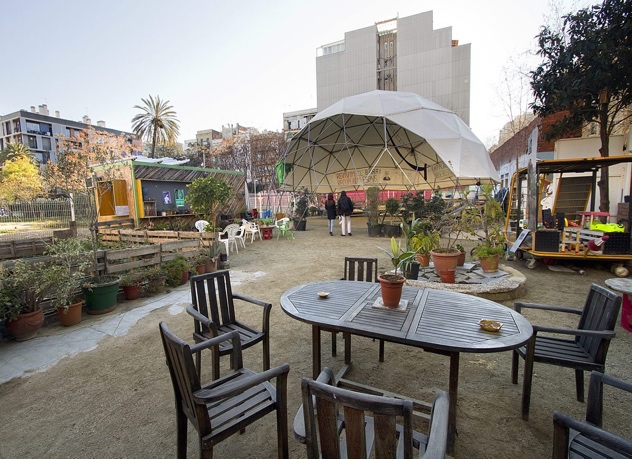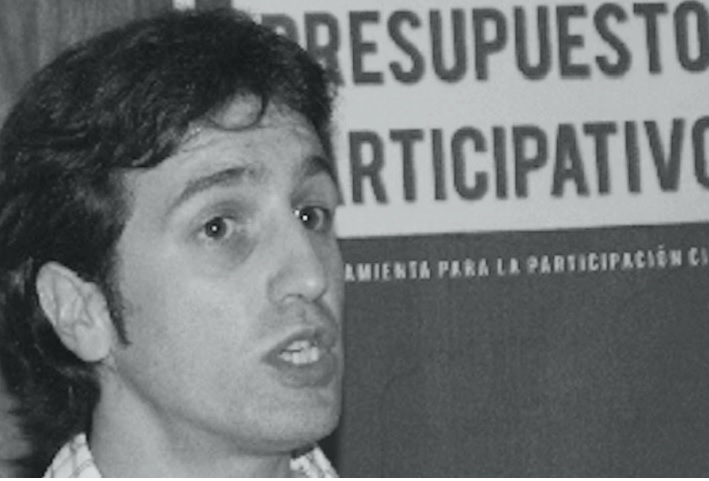Event 2 | Day 1
The Commons and Participative Democracy2017, May 8 | Barcelona, Spain
The first day of training focuses on citizen participation approaches, social innovation and participative governance. This session is designed and delivered by the Public Governance Institute of Barcelona Autonomous University (IGOP).
Participative Governance & Social Innovation
Morning session by Dr. Marc Parés (IGOP)
Participative democracy
Governance, understood as the creation of a structure of governing resulting from the interaction of a multiplicity of influencing actors (Kooiman, 2003), concerns itself with specific forms of social life regulation in which boundaries between and within public and private sectors have become blurred (Stoker, 1998). Consequently, governance is by definition a hybrid mode of social life regulation where multiple actors and different spheres (state, economy and society) are engaged. However, after more than two decades of governance research, we have learned that there is no one single, but different modes of governance, departing from different values, responding to different ideological persuasions and resulting in different outputs and outcomes (Bevir, 2010; Kooiman, 2003; Parés, 2009; Pierre, 1999). Participative governance, thus, is a specific mode of governance aiming to engage citizens in social life regulation.
Given the proliferation of variegated forms of collaboration between governmental and nongovernmental stakeholders in cities during the last decades, research and theory on governance networks has been especially relevant in Urban Studies. Empirical studies of urban governance have proliferated, particularly those exploring public and third sector collaboration (Parés, Marti-Costa and Blanco 2014; Davies and Pill 2012; Durose and Lowndes 2010). In this vein, Ansell and Gash (2008) argued that by the turn of the century “collaborative governance” had emerged as a new form replacing adversarial and managerial forms of policy making.
Although different perspectives have been used to analyze local governance under neoliberalism (Guarneros-Meza & Geddes, 2010; Lowndes & Sullivan, 2008), Geddes’ (2008) review demonstrated that despite diversity in form, purpose and discourse; ‘collaborative governance’ was becoming hegemonic across European cities before the Great Recession (see also Davies 2011). However, several commentators have argued that the onset of austerity policies since the financial crash has dampened the former enthusiasm for network governance, as local governments across Europe have sought to rationalize their interactions with citizens (Davies & Pill, 2012; Durose & Rees, 2012). On the other hand, the former collaborative mechanisms characterized by ‘participation-by-invitation’ started to be challenged and/or replaced by innovative forms of ‘participation-bymobilization’ (Bonet-Martí, 2014). Undoubtedly, new discourses, strategies and approaches to urban governance are emerging from below, especially since 2011, when insurrectional urban interventions became a recurrent motif of many political protests worldwide, as well as in Spain (Subirats & Martí-Costa, 2015). Hence, collaborative urban governance seems to be challenged not only by austerity politics but also by alternative, innovative and/or insurgent forms of political participation.
Social innovation
Evidence in many places around the world suggests that citizens are, increasingly, selforganizing to produce innovative solutions as they face the collective problems that governments are failing to solve in a context of scarcity and austerity policies. Some of these responses are socially innovative initiatives. They are social in their roots – growing from societal actors like social movements, the third sector, the non-profit world, and grassroots organizations – and also social in their goals, which aim to address unmet social needs. They are innovative because they constitute alternatives to the hegemonic solutions provided by governments and markets. Hence, social innovation is not found within the workings of government or markets, although it may be significantly related to both. While innovative, such initiatives are not necessarily entirely new, and they should be understood in the context of historical and geographical processes of collective action. We define social innovation as a complex process of the introduction of novel solutions to face social problems – ideas, products, services or models – that profoundly change the basic routines, beliefs or resource and authority flows of the social system in which they occur (Westley & Antadze, 2010). These solutions are introduced by citizens and civil society actors that find no adequate solutions in the private market or in macro-level welfare policies (Oosterlynck, Kazepov, Wukovitsch, Sarius, & Leubolt, 2013). The aim of such initiatives is to satisfy alienated social needs, to empower citizens and to transform social and power relationships (Moulaert, MacCallum, Mehmood, & Hamdouch, 2013).
Reading references
Ansell, C., & Gash, A. (2008). Collaborative Governance in Theory and Practice. Journal of Public Administration Research and Theory, 18(4), 543–571. http://doi.org/10.1093/jopart/mum032
Bevir, M. (2010). Democratic governance. Princeton: Princeton University Press.
Bonet-Martí, J. (2014). La participació ciutadana en l’urbanisme: potencials i límits. Revista Papers. Institut d’Estudis Regionals I Metropolitans de Barcelona., (57), 63–70.
Davies, J. (2011). Challenging Governance Theory: From Networks to Hegemony. Bristol: Policy Press.
Davies, J., & Pill, M. (2012). Empowerment or Abandonment? Prospects for Neighbourhood Revitalization under the Big Society. Public Money and Management, 32(3), 193–200.
Durose, C., & Lowndes, V. (2010). Neighbourhood governance: Contested rationales within a multilevel setting – a study of Manchester. Local Government Studies, 36(3), 341–359. http://doi.org/10.1080/03003931003730477
Durose, C., & Rees, J. (2012). The rise and fall of neighbourhood in the New Labour era. Policy and Politics, 40(1), 38–54. http://doi.org/10.1332/030557310X550079
Geddes, M. (2008). Inter-organizational relationships in local and regional development partnerships. In S. Cropper, M. Ebers, C. Huxham, & P. Smith Ring (Eds.), The Oxford Handbook of Interorganizational relations (pp. 203–230). Oxford: Oxford University Press.
Guarneros-Meza, V., & Geddes, M. (2010). Local Governance and Participation under Neoliberalism: Comparative Perspectives. International Journal of Urban and Regional Research, 34(1), 115–129. http://doi.org/10.1111/j.1468-2427.2010.00952.x
Kooiman, J. (2003). Governing as governance. London: SAGE. Lowndes, V., & Sullivan, H. (2008). How low can you go? Rationales and challenges for neighbourhood governance. Public Administration, 86(1), 53–74. http://doi.org/10.1111/j.1467-9299.2007.00696.x
Moulaert, F., MacCallum, D., Mehmood, A., & Hamdouch, A. (2013). The International Handbook OnSocial Innovation. Northampton, MA: Edward Elgar.
Oosterlynck, S., Kazepov, Y., Wukovitsch, F., Sarius, T., & Leubolt, B. (2013). The butterfly and the elephant : local social innovation , the welfare state and new poverty dynamics (No. 13/03).
Parés, M. (2009). Participación y calidad democrática: evaluando las nuevas formas de democracia participativa. Barcelona: Ariel.
Parés, M., Marti-Costa, M., & Blanco, I. (2014). Geographies of governance: How place matters in urban regeneration policies. Urban Studies, 51(15), 3250–3267. http://doi.org/10.1177/0042098013513647
Pierre, J. (1999). Models of Urban Governance: The Institutional Dimension of Urban Politics. Urban Affairs Review, 34(3), 372–396. http://doi.org/10.1177/10780879922183988
Stoker, G. (1998). Governance as theory: five propositions. http://doi.org/10.1111/1468-2451.00106
Subirats, J., & Martí-Costa, M. (2015). Ciudades y cambio de época: discursos sobre políticas urbanas y crisis en España. Bilbao: Universidad del País Vasco.
Westley, F., & Antadze, N. (2010). Making a Difference Strategies for Scaling Social Innovation for Greater Impact. Innovation Journal: The Public Sector Innovation Journal, 15(2), 1–19.
The Commons: Participative approaches in green urban spaces
Afternoon session by Mara Ferreri (IGOP)
The commons and urban public spaces
In contemporary cities, collaborative greening projects have become a favoured format for the temporary use of vacant spaces. The open public encounters generated through such projects have been described as instances of guerrilla urbanism, capable of producing shortand long-term urban transformations, as well as different ´texture of experience´ in cities. This session will introduce ways of understanding urban commons in relation to green spaces and their “publicness” to reflect on established understandings of urban public ,spaces and “publicness” as imagined and produced. Drawing on critical debates in urban geography and architecture, the session will examine how everyday dimensions of engagement with vacant spaces through forms of collective gardening can be potentially challenging and can expand on existing spatial dynamics, having a much wider impact in terms of local participative approaches to the urban.
Citizen participation approaches and the question of temporariness
Practitioners and researchers have highlighted how green spaces can be understood as examples of ‘actually existing commons’ in contemporary cities. Such spaces require critical attention to both frameworks of use and to the existence of a community or collective responsible for such use and for managing wider participation. The session will argue that practices of green commoning need to be critically understood both in terms of the social, economic and policy conditions under which such practices are established and developed, and in terms of participation and access, particularly in contexts of ‘austerity urbanism’ ,(Tonkiss, 2013). Examples from the United Kingdom and France will be offered as illustrations of a range of critical issues that need to be addressed when looking at participation in urban commoning practice through temporary green projects.
Reading references
Eizenberg, E. (2012) ‘Actually Existing Commons: Three Moments of Space of Community Gardens in New York City’. Antipode 44 (3): 764–82
Fernández, M. And J. Gifreu, (eds) (2016) El uso temporal de los vacíos urbanos. Barcelona: Diputació de Barcelona.
Ferreri, M. (2015) The seductions of temporary urbanism. Ephemera, 15(1), http://www.ephemerajournal.org/contribution/seductions-temporary-urbanism
Hou, J. (ed.) (2010) Insurgent public space: guerrilla urbanism and the remaking of contemporary cities. London: Routledge.
Mould, O. (2014) Tactical urbanism: The new vernacular of the creative city. Geography Compass, 8(8), 529-539.
Petrescu, D., Querrien, A., Petcou, C. (2007) Agir urbain, Multitudes, 2007/4 (No 31), p. 11-15. DOI : 10.3917/mult.031.0011. URL : http://www.cairn.info/revue-multitudes-2007-4-page-11.htm
Petcou, C. and Petrescu, D. (2015) R-URBAN or how to co-produce a resilient city. Ephemera, vol. 15, no 1, http://www.ephemerajournal.org/sites/default/files/pdfs/contribution/15- 1petcoupetrescu.pdf. See also: http://r-urban.net/blog/activities/avec-vous-lagrocite-continue-malgres-tout/
Tonkiss, F. (2013) Austerity urbanism and the makeshift city. City: analysis of urban trends, culture, theory, policy, action, 17(3), 312-324.
Thompson, M. (2015) ‘Between Boundaries: From Commoning and Guerrilla Gardening to Community Land Trust Development in Liverpool’. Antipode 47 (4): 1021–42.
Technical visit: Espais Buits – Espai Germanetes
Location: intersection of Carrer del Consell de Cent & Carrer de Viladomat – see map link

Espai Germanetes is a community-operated project on the former site of a convent in the Esquerra de l’Eixample neighbourhood. Still undeveloped years after its 2006 acquisition by the City, the site attained its new purpose through the emergence of a citizen initiative, Recreant Cruïlles, in 2011. The initiative, born as a working group within the established local neighbourhood association, supports resident demands for much needed public and green space in the area. Hosting celebrations, workshops, public art activities, protests and pedestrianization events, the space is a noncommercial, public space, open to all.
Initiated in 2012, the municipally-run Pla BUITS contest seeks out proposals by public or non-profit community groups for the provisional activation and revitalization of unused land in the city. Now in its second edition, the contest has selected projects based on their incorporation of the public interest and civil society in activities that are highly impactful, have a temporary physical setup, and are self-sustaining. Espai Germanetes is one of the spaces recognized by the Pla BUITS program.
Reading references
Espai Germanetes/Recreant Cruïlles:
https://recreantcruilles.wordpress.com/espai-germanetes/
http://bcncomuns.net/es/cpt/germanetesrecreant-cruilles-2/
Pla BUITS:
Day 1 Presenters
Dr. Marc Parés
Coordinator, Research Group on Urban Governance, Commons, Internet and Social Innovation (IGOP)
Marc Parés is a geographer and political scientist leading the Research Group on Urban Governance, Commons, Internet and Social Innovation at the Institute for Government and Public Policies (IGOP) – Autonomous University of Barcelona (Spain). He also teaches as Lecturer at the Geography Department.
From 2014 to 2016 he had a Marie Curie Fellowship, being Visiting Scholar at the NYU Robert F. Wagner Graduate School of Public Service (USA) and the KU Leuven Planning and Development Unit (Belgium). He has also been a postdoctoral researcher in the School of Environment and Development at the University of Manchester (UK). He has a Ph.D., a MSc and a BSc in Environmental Sciences from the Autonomous University of Barcelona and a BA in Political Sciences from the same university.
His research has been focused on the fields of Urban Governance, Citizen Participation, Urban Political Ecology, Environmental Management and Social Innovation. He has published in journals like Urban Studies, Urban Affairs Review, European Planning Studies, Journal of Urban Affairs or the International Journal of Urban and Regional Research. In 2009 he edited the book ‘Participation and Democratic Quality: assessing new forms of participatory democracy’, published by Ariel. He is co-author of the book “Social Innovation and Democratic Leadership: Communities and Social Change from Below”, recently published by Edward Elgar Publishing.

Dr. Mara Ferreri
Postdoctoral Researcher, Public Governance Institute of Barcelona Autonomous University (IGOP)
Mara is a postdoctoral researcher working at the intersection of urban, cultural and political geography. In 2013, she received her PhD in Geography from Queen Mary University of London with a thesis on the politics of temporary use of vacant spaces. Her research interests include temporary urbanism, precariousness, gentrification, self-organisation and movements for housing justice. Her work has been published in several international journals (such as Transactions of the IBG, Cities, Ephemera) and edited volumes, including Space, Power and the Commons (Routledge, 2016) and Cities Interrupted: Visual Cultures and Urban Space (Bloomsbury, 2016). She is the author of the book Notes from the Temporary City (public works, 2016), with Andreas Lang. Before coming to IGOP, she held teaching and research positions in Geography and Social Research Methods at Queen Mary University of London, the London School of Economics and Durham University.


This project has been founded by the EU Commission under the Erasmus+ program
This website is the sole responsibility of the author and the Commission is not responsible for any use that may be made of the information contained therein.
